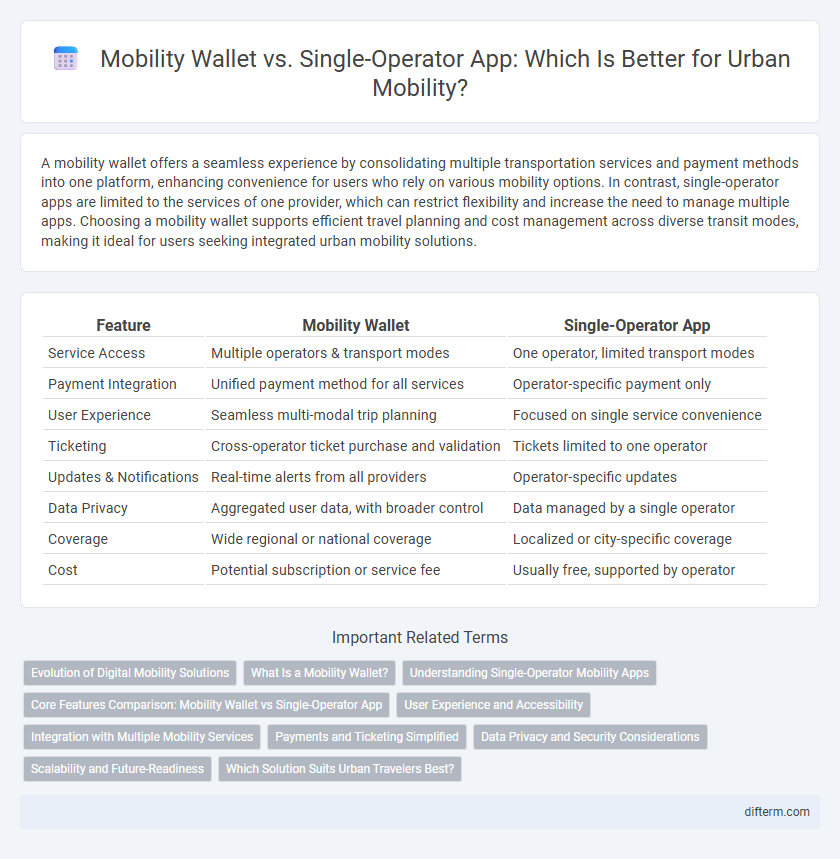A mobility wallet offers a seamless experience by consolidating multiple transportation services and payment methods into one platform, enhancing convenience for users who rely on various mobility options. In contrast, single-operator apps are limited to the services of one provider, which can restrict flexibility and increase the need to manage multiple apps. Choosing a mobility wallet supports efficient travel planning and cost management across diverse transit modes, making it ideal for users seeking integrated urban mobility solutions.
Table of Comparison
| Feature | Mobility Wallet | Single-Operator App |
|---|---|---|
| Service Access | Multiple operators & transport modes | One operator, limited transport modes |
| Payment Integration | Unified payment method for all services | Operator-specific payment only |
| User Experience | Seamless multi-modal trip planning | Focused on single service convenience |
| Ticketing | Cross-operator ticket purchase and validation | Tickets limited to one operator |
| Updates & Notifications | Real-time alerts from all providers | Operator-specific updates |
| Data Privacy | Aggregated user data, with broader control | Data managed by a single operator |
| Coverage | Wide regional or national coverage | Localized or city-specific coverage |
| Cost | Potential subscription or service fee | Usually free, supported by operator |
Evolution of Digital Mobility Solutions
Mobility wallets integrate multiple transportation services into a unified platform, enabling seamless access to buses, trains, bike shares, and ride-hailing within a single app. Single-operator apps, while effective for focused service delivery, limit user convenience by restricting options to one provider's network. The evolution of digital mobility solutions increasingly favors interoperable wallets that enhance user experience through consolidated payment, real-time data, and personalized travel planning across diverse mobility modes.
What Is a Mobility Wallet?
A mobility wallet is a digital platform that consolidates multiple transportation services, such as public transit, bike-sharing, and ride-hailing, into a single app, offering unified payment and ticketing options. Unlike single-operator apps that focus on one mode or provider, mobility wallets provide seamless access to diverse mobility solutions across different operators and regions. This integration enhances user convenience, promotes multimodal transport, and supports sustainable urban mobility goals.
Understanding Single-Operator Mobility Apps
Single-operator mobility apps streamline urban travel by integrating services like bike-sharing, ride-hailing, and public transit within one platform, tailored to a specific provider's offerings. These apps offer real-time vehicle availability, booking, and payment options but lack the comprehensive access provided by mobility wallets that aggregate multiple operators. Understanding the limitations and targeted convenience of single-operator apps is essential for users seeking seamless multimodal transportation across different service providers.
Core Features Comparison: Mobility Wallet vs Single-Operator App
Mobility wallets aggregate multiple transport services into a single platform, enabling seamless ticketing, real-time updates, and unified payment options across various operators. Single-operator apps typically offer specialized features tailored to a specific transit provider, such as detailed route planning, loyalty rewards, and operator-specific promotions. Core features of mobility wallets emphasize interoperability and convenience, while single-operator apps focus on depth of service and personalized user engagement within one network.
User Experience and Accessibility
A mobility wallet offers seamless integration across multiple transportation providers, enhancing user experience by consolidating ticket purchases, payment options, and real-time updates in one platform. In contrast, single-operator apps limit accessibility by restricting services to one provider, often requiring multiple apps for different transport modes and complicating journey planning. Enhanced user convenience and accessibility from a mobility wallet reduce travel friction, making it easier for users to navigate diverse transport networks efficiently.
Integration with Multiple Mobility Services
A mobility wallet integrates multiple transportation options such as buses, trains, bike-sharing, and ride-hailing services into a single platform, enabling seamless payment and trip planning across various operators. In contrast, a single-operator app typically limits users to services provided by one company, restricting flexibility and coverage in urban mobility networks. Comprehensive integration in mobility wallets enhances user convenience and fosters interoperability within smart city infrastructures.
Payments and Ticketing Simplified
Mobility wallets streamline payments and ticketing by consolidating multiple operators into one app, enabling seamless fare purchases and real-time ticket validation across diverse transit networks. Single-operator apps limit users to one service provider, causing fragmentation and inconvenience for multi-modal travelers. Integrated mobility wallets enhance user experience by offering unified payment methods, reducing queue times and promoting frictionless mobility.
Data Privacy and Security Considerations
Mobility wallets offer enhanced data privacy by aggregating multiple transportation services under one secure platform, reducing the risk of data fragmentation and unauthorized access. Single-operator apps, while streamlined, often limit data control to one service, increasing vulnerability if the operator experiences a security breach. Prioritizing end-to-end encryption and user consent protocols, mobility wallets provide a more robust framework for safeguarding personal and transactional data across various mobility providers.
Scalability and Future-Readiness
Mobility wallets offer superior scalability by integrating multiple transportation services into a unified platform, enabling seamless user access across various operators and modes. Their architecture supports future-readiness through modular design and API-driven connections, facilitating easy addition of new services and technologies without overhauling the system. In contrast, single-operator apps lack this flexibility, limiting expansion potential and adaptability in evolving urban mobility ecosystems.
Which Solution Suits Urban Travelers Best?
Mobility wallets provide urban travelers with a seamless multimodal experience by integrating payments and ticketing across buses, trains, bike-sharing, and ride-hailing services, enhancing convenience and reducing app fatigue. Single-operator apps, while offering optimized features for a specific transit system, often limit flexibility and require users to switch apps for different transport modes. For urban travelers seeking versatility and efficiency, mobility wallets outperform single-operator apps by consolidating access and simplifying transactions across diverse mobility options.
mobility wallet vs single-operator app Infographic

 difterm.com
difterm.com